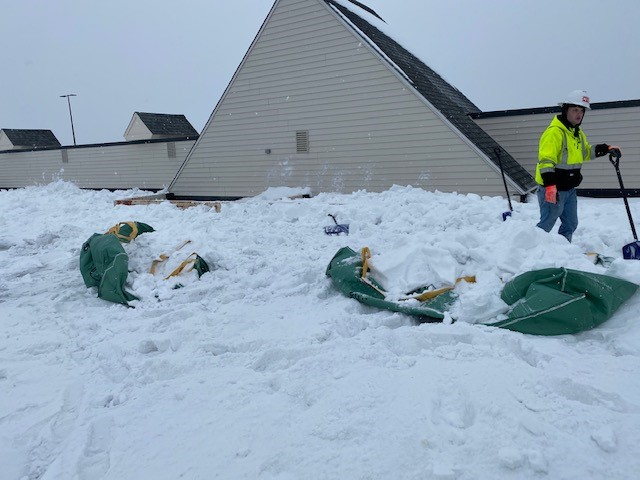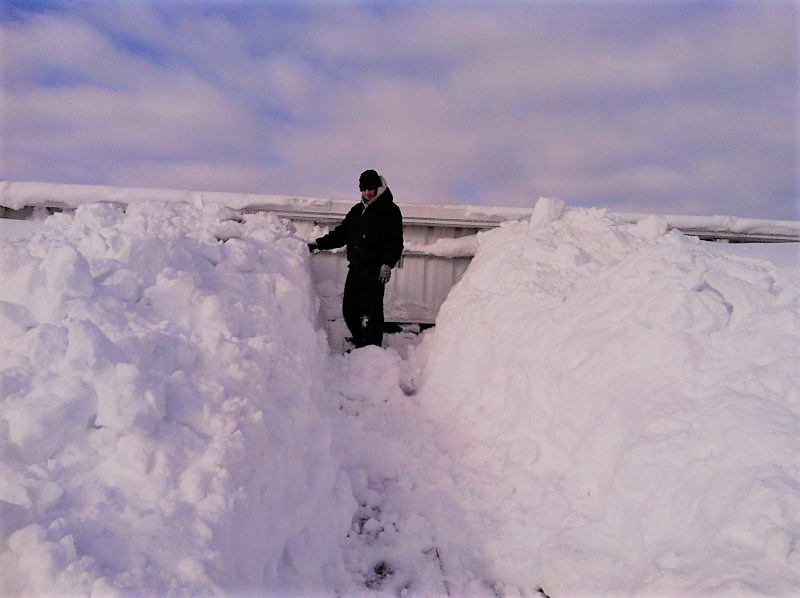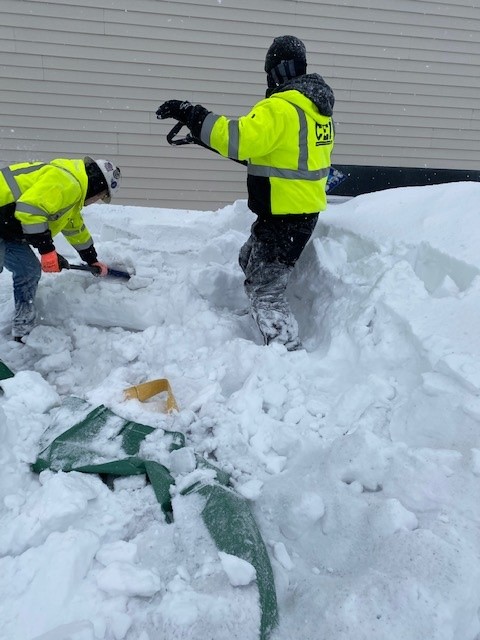
While most people in cold climates dream of a White Christmas or a big fluffy snow fall for the many wonderful outdoor activities, snow and ice can be dangerous and damage your commercial roofing systems.
With over 50 years of experience, in some of the coldest climates in the United States, CEI knows how imperative it is for building owners to minimize potential damage to their roof systems by preventing snow and ice buildup during the coldest months of the year. If you’re in a cold climate, your commercial flat roof may need to have snow removed a few times throughout the winter. Snow buildup on the roof can cause several issues with the roof and the rest of the building. On the other hand, quick, careless, and improper snow removal done by those that do not know or appreciate the complexities of a roof system can cause a lot of damage to the roof membranes.
To avoid most of these preventable problems, CEI recommends working with a professional roofer who is trained to identify specific safety hazards such as snow covered skylights and equipment. These professionals will put together a winter snow removal plan, tailored to your specific building.
Snow should be removed from a flat roof because it can do the following:
- Blocked access to building systems: Snow collection on commercial flat roofs may block access to key building features and systems, including HVAC equipment, plumbing vents, and more. Snow may prevent roof and building systems from functioning properly.
- Snow and ice may fall off roof edges: If left, snow or icicles can gather on roof edges and drop down onto the people or property below. Falling snow and ice could cause injuries to staff or members of the public. It may also damage your property. Snow may also cause damage to roofing membranes on lower roof surfaces as heavy loads of snow or ice fall from the roof surface above.
- Damage to the drainage system: If snow isn’t removed from the rooftop, it will eventually melt and enter the drainage system. While internal systems are typically warm enough to prevent re-freezing in the pipes, external drainage systems may not be. As ice expands when it freezes, it may damage the drainage system.
- Damage to the roofing membranes: The freeze and thaw cycle may damage roof membranes. Snow melts during the day and, as temperatures drop at night, the resulting water freezes into ice. Water may work its way into cracks of the roof membrane, which are then made worse as the water freezes and expands. As this cycle may occur daily, the damage may be serious. It is also more challenging to remove snow that has partially frozen into ice.
- Heavy loads of snow: Snow weight can exceed a roof’s weight capacity and cause a collapse. Though this is a rare circumstance it is serious and proper snow management should address this possibility.
There are many negative effects of unmanaged snow on your commercial roof, but you can avoid them. CEI can come out to your roof today, make an assessment and put a plan in place to help avoid any potential problems during the winter months.

Here is what you can expect from with a CEI Snow Removal Plan
- Plan for Removal: Snowfall may hide or obscure roof features that are usually visible. CEI will work with your roof plan to map your roof and place flags or other markers to indicate roof features such as skylights, vents and HVAC equipment. These markers will help our roofers stay safe and avoid harming these features as they remove the snow.
- Determine Snow Storage: Snow should not be piled on the roof even temporarily. Therefore, the roofers must designate spots on the ground to hold snow. Typically, they will choose spots that are far from entrances and exits, fire escapes and other building features. If your roof is very large, you may need to move the snow off-site.
- Start with Safety: There are many safety regulations and rules surrounding working in the cold winter weather. CEI knows all of the relevant regulations and ensures they will be followed.
- Bring Equipment to the Roof: Professional roofers will have the necessary equipment specifically geared towards the safe and efficient removal of snow. Without the proper equipment, snow removal may damage roofing materials and roof features.
- Remove Drifted Snow: Snow piles from the wind, such as behind HVAC equipment or on lower roof planes must be removed first and foremost in order to relieve stress from these critical areas. Roofing professionals such as CEI may gather snow on tarps or in containers and then have a crane or other lifting equipment remove the tarp or the container from the roof. If the roofers are dumping the snow off the tarp at the edge of a roof, they should first ensure no one has access to the dumping spot. Also, snow typically must be moved from this spot to a safe, permanent location where it is out of the way of those who use the building.
- Remove Other Snow: Now the roofers will remove the rest of the snow from the roof. Typically, they will divide the roof into sections and work on each, dumping the snow when the section is finished.
- Inspection: Any roofing work should finish with an inspection and snow removal is no different. If a roofer has accidentally damaged the roofing membrane it is best to know now so that the roofer can fix it as soon as possible.

It is not very often that a properly designed and installed roof will collapse from small amounts of snow build-up, but vulnerabilities in the roof, extreme weather, poor design, poor roof maintenance, poor drainage and other unusual circumstances can cause a collapse.

Complete collapse isn’t the only risk of excess snow. Here are some warning signs of building stress/fatigue after a snowfall:
- Ceiling problems: A ceiling that appears to sag, or sprinkler lines and sprinkler heads that look lower than normal.
- Unusual noises: Creaking, popping and cracking can be a sign of a stressed roof.
- Roof member problems: Any portion of a roof or roof truss which sags is a cause for concern.
- Drainage problems: Unusual collections of water on the flat roof may be a sign this area has sunken. These sunken spots may only be visible after the snow has melted.
- Door and window problems: If a door or window can no longer be opened or closed it may be a sign the roof or walls have shifted under the weight of snow.
- Wall problems: Drywall, masonry and other wall materials may crack under pressure from an overloaded roof.
If you discover any of these signs, it is not wise to step onto the roof, not even to remove the snow. Instead, call a professional roofer like CEI to create a snow removal plan that will not increase the odds the roof will take on more damage or ultimately collapse.